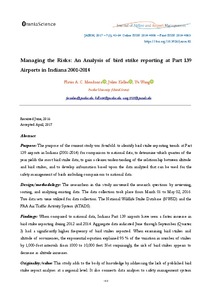Mostra el registre d'ítem simple
Managing the Risks: An Analysis of bird strike reporting at Part 139 Airports in Indiana 2001-2014
| dc.contributor.author | Mendoca, Flavio A.C. |
| dc.contributor.author | Keller, Julius |
| dc.contributor.author | Wang, Yu |
| dc.coverage.spatial | east=-86.15478515625; north=39.75787999202175; name=Indianapolis, Indiana, Estats Units d'Amèrica |
| dc.date.accessioned | 2017-06-13T14:21:18Z |
| dc.date.available | 2017-06-13T14:21:18Z |
| dc.date.issued | 2017-06 |
| dc.identifier.citation | Mendoca, F. A.; Keller, J.; Wang, Y. Managing the Risks: An Analysis of bird strike reporting at Part 139 Airports in Indiana 2001-2014. "Journal of Airline and Airport Management", Juny 2017, vol. 7, núm. 1, p. 43-64. |
| dc.identifier.uri | http://hdl.handle.net/2117/105387 |
| dc.description.abstract | Purpose: The purpose of the current study was fourfold: to identify bird strike reporting trends at Part 139 airports in Indiana (2001-2014) for comparison to national data; to determine which quarter of the year yields the most bird strike data; to gain a clearer understanding of the relationship between altitude and bird strikes, and to develop information based upon the data analyzed that can be used for the safety management of birds including comparisons to national data. Design/methodology: The researchers in this study answered the research questions by reviewing, sorting, and analyzing existing data. The data collection took place from March 01 to May 02, 2016. Two data sets were utilized for data collection. The National Wildlife Strike Database (NWSD) and the FAA Air Traffic Activity System (ATADS). Findings: When compared to national data, Indiana Part 139 airports have seen a faster increase in bird strike reporting during 2012 and 2014. Aggregate data indicated June through September (Quarter 3) had a significantly higher frequency of bird strikes reported. When examining bird strikes and altitude of occurrences, the exponential equation explained 95 % of the variation in number of strikes by 1,000-foot intervals from 1000 to 10,000 feet. Not surprisingly, the risk of bird strikes appears to decrease as altitude increases. Originality/value: This study adds to the body of knowledge by addressing the lack of published bird strike report analyses at a regional level. It also connects data analyses to safety management system (SMS) concepts and Wildlife Hazards Management Programs (WHMP). The aviation community can use regional bird strike data and information to develop or enhance existing wildlife hazard management programs, increase pilot awareness, and for refinements in the development and implementation of integrated research and operational efforts to mitigate the risk of bird strikes. |
| dc.format.extent | 22 p. |
| dc.language.iso | eng |
| dc.publisher | OmniaScience |
| dc.rights | Attribution-NonCommercial 3.0 Spain |
| dc.rights.uri | http://creativecommons.org/licenses/by-nc/3.0/es/ |
| dc.subject | Àrees temàtiques de la UPC::Aeronàutica i espai::Aeroports |
| dc.subject.lcsh | Airports--Indiana |
| dc.subject.lcsh | Aircraft accidents--Indiana |
| dc.subject.lcsh | Airports--Bird control |
| dc.subject.other | Aviation safety |
| dc.subject.other | Bird strikes |
| dc.subject.other | Wildlife management |
| dc.subject.other | Safety management systems |
| dc.title | Managing the Risks: An Analysis of bird strike reporting at Part 139 Airports in Indiana 2001-2014 |
| dc.type | Article |
| dc.subject.lemac | Aeroports -- Estats Units d'Amèrica -- Indiana |
| dc.subject.lemac | Avions -- Accidents |
| dc.subject.lemac | Aeroports -- Control d'ocells |
| dc.identifier.doi | 10.3926/jairm.82 |
| dc.description.peerreviewed | Peer Reviewed |
| dc.rights.access | Open Access |
| local.citation.publicationName | Journal of Airline and Airport Management |
| local.citation.volume | 7 |
| local.citation.number | 1 |
| local.citation.startingPage | 43 |
| local.citation.endingPage | 64 |


